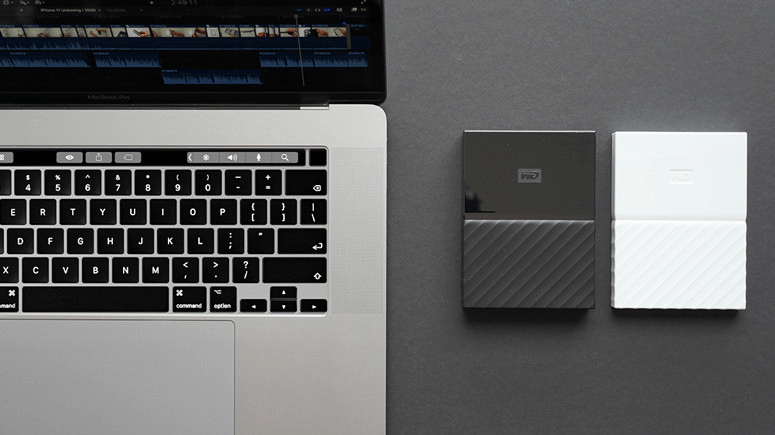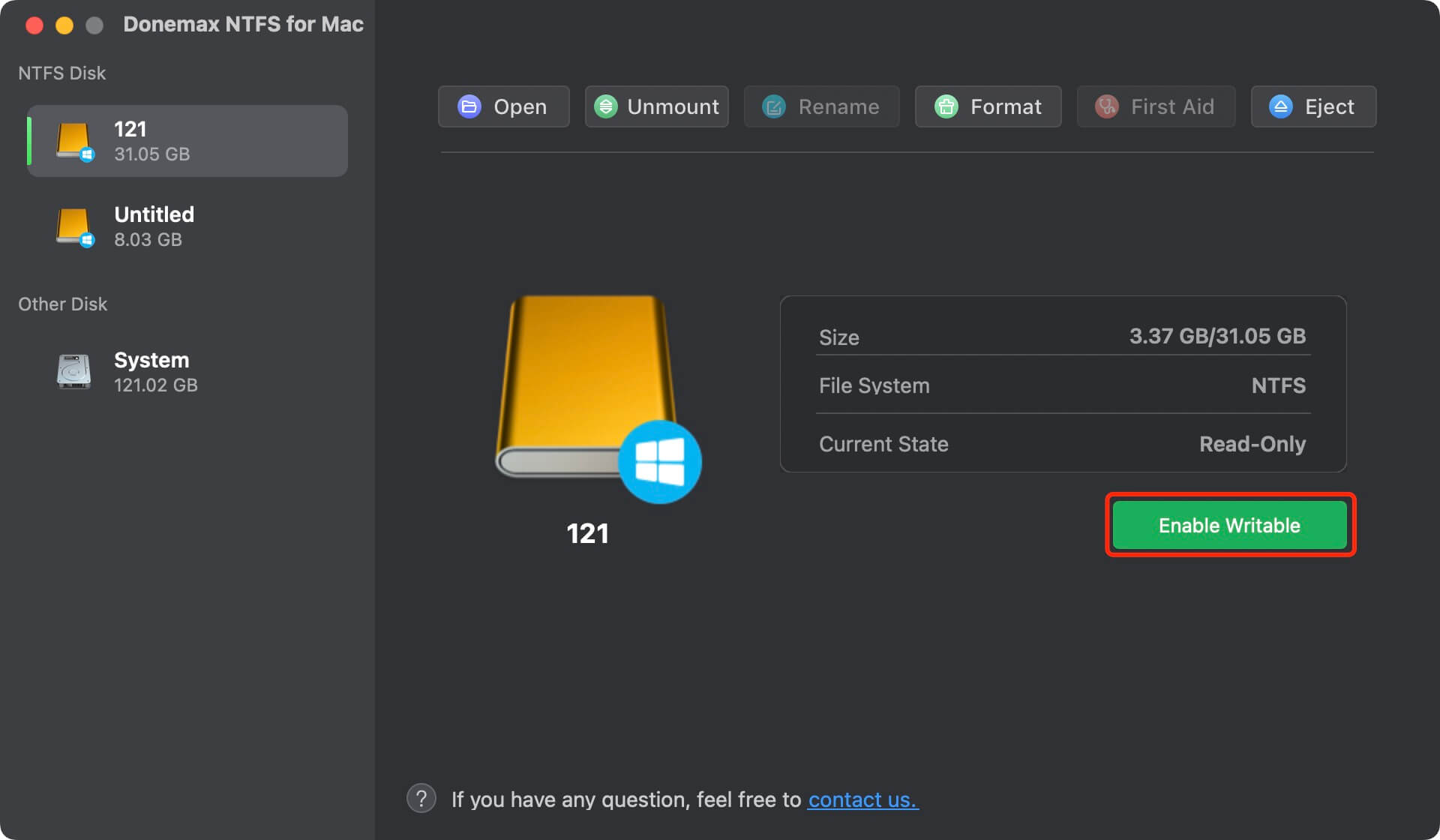Is transferring data from your Mac to an external hard drive giving you trouble? You may be trying to connect the external HDD or SSD to your Mac for the first time. Unfortunately, you seem to be having some difficulties with it.
PAGE CONTENT:

Are you searching online for answers to your problems? Relax, it's not as tough as you would imagine. If you read on, you'll find out how to repair the problem and copy files from your MacBook, iMac, Mac to the external hard drive. Excited to find out the process! Put on your seatbelts, and we'll get going.
Fix an external hard drive or USB device that won't copy files
👉#1 Make sure your external drive has enough space
You might have reached the storage capacity of your device. If this occurs, a warning will appear when you try to add files to the disk.
So, before copying data, ensure your external hard drive has adequate room.
To view the available space on your external hard drive, navigate to the Apple menu > About This Mac > Storage. If there isn't enough room on the drive, old files can be erased to create a way for the new ones.
👉#2 Verify the disk-Mac connection
Recent Macs only support the USB-C standard for connecting external devices and USB sticks. Verify the integrity of the cable connections on both ends of the disk you're trying to attach has a USB-C interface. If it is, and the Mac still won't mount the disk, try switching the cable. If the drive doesn't have a USB-C port, you'll need to use an adapter; if so, ensure the two devices are properly linked.
👉#3 Check external hard disk permission settings
If the external hard drive has been formatted to be compatible with macOS, but you still can't add folders, the problem may lie in the disk's permission settings. The external disk may be read-only for the user you're logged in with. Here are the procedures you need to take to verify the external hard drive's permissions:
- Step 1. First, select "Get Info" by right-clicking the external hard disk.
- Step 2. View each user's permissions for the disk in the "Sharing & Permissions" section at the bottom of the details pane.
- Step 3. Changing the permissions on an external hard drive can grant you read/write access if you don't already have it.
- To access admin features, click the padlock icon at the bottom and input your password.
- Select the account name you're presently using to access your Mac under "Sharing & Permissions."
- Raise this user's permission level to "Read & Write."
- Step 4. The external hard drive's permissions may be easily reset to save fresh data without restriction.
👉#4 Try various methods to copy files to the external disk
You might attempt an alternative file transfer method if you have problems copying data to an external hard disk. For instance, you may switch to the drag-and-drop approach if you struggle with the copy-and-paste method.
- If you suspect your Mac's copy-and-paste functionality is broken, try moving a file from one folder to another. If it doesn't work, you can copy and paste the files from your Mac to the external disk.
- You may use the "Ctrl + C" and "Ctrl + V" keyboard keys to copy the files and then paste them to your external drive if the drag-and-drop approach doesn't work on your Mac.
- The Mac's functionality may prevent copying some files or folders, but you can still copy them using an alternative technique or program.
- Check for and fix drive issues by using First Aid.
A faulty external hard drive might also prevent you from adding new folders to your Mac. To diagnose and fix disk faults, utilize the First Aid option in Disk Utility. To launch First Aid on the external HD:
- First, from the dock's Launchpad, go to Other > Disk Utility.
- Second, in the Disk Utility pane, choose the external hard disk.
- Third, from the main menu, select the First Aid button; finally, press the "Run" button to confirm; finally, wait for the procedure to finish.
It will verify that the external hard drive is error-free so that you may add folders to it from your Mac.
How to use an NTFS external hard drive on Mac without formatting?
In most cases, the reason why you can’t copy files from your Mac to an external hard drive is that the external hard drive is an NTFS hard drive. NTFS file system is Windows-based file system and is read-only on Mac so you can’t copy or move files from Mac to it. If you want to use an NTFS external hard drive on Mac without formatting it to exFAT or APFS, you can download and install a NTFS for Mac tool.
Donemax NTFS for Mac is an easy-to-use and 100% safe NTFS for Mac tool. It can help you securely and quickly enable read-write for NTFS drives on Mac. Follow the steps below:
Step 1. Connect the NTFS drive to your Mac and open Donemax NTFS for Mac from Launchpad.
Step 2. Find and select the NTFS drive, click Enable Writable.

After enabling writable for NTFS drives, you can copy files from your Mac to the external hard drive without any limitation and you also can save new files, edit files, delete or copy, cut files on the external hard drive.
What can external hard drive do on Mac?
- Back Up Data: You can copy files from your Mac to the external hard drive to make a simple backup. You also can copy or clone your Mac hard drive to the external hard drive to get a full Mac backup.
- Create Bootable Clone: Clone Mac startup disk to the external hard drive and make it be bootable with disk cloning software.
- Transfer data between Mac and PC: Transfer data between Macs and PCs.
Conclusion:
You may do a few more things if you've already tried them and still can't copy data from your Mac to an external hard drive. Whether you've exhausted all other options, you can try attaching a separate external hard drive to your Mac and see if you can copy files. This drive should be formatted with either HFS+, FAT32, or APFS. If you want to use a Windows-based hard drive on Mac, you can download a NTFS for Mac tool to help you to remove the NTFS limitations.
Related Articles
- Aug 15, 2023Fixed: Can't Delete Files from An USB Flash Drive on Mac
- Nov 20, 2024Fix NTFS Drive is Read-Only on macOS Big Sur
- Jun 30, 2023How to Write Data to NTFS Drive on Mac?
- Jun 12, 2025How to Format and Unformat An NTFS Hard Drive on Mac?
- Dec 17, 2024Can Mac Write Data to NTFS Drive?
- Dec 25, 2024NTFS Extension for Mac, NTFS Driver for Mac, NTFS Plugin for Mac

Lucien
Lucien is a writer and a chief programmer of Donemax software who has worked in the company for 5+ years. He has written much of the content on the site and devotes to providing troubleshooting and solution for Windows and Mac users including disk cloning, data recovery, migration, eraser, error fixes.

Gerhard Chou
In order to effectively solve the problems for our customers, every article and troubleshooting solution published on our website has been strictly tested and practiced. Our editors love researching and using computers and testing software, and are willing to help computer users with their problems
